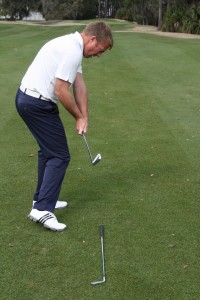A Clubface Primer
/It is important to understand that the angle of the clubface will influence a golfers' ability to get into a proper impact position. Athletic instinct will always compensate in order to position the face squarely (or as squarely as possible!) at contact. Thus, a square clubface will allow any golfer to naturally more repeatable impact position.
There are three good check points that occur prior to impact to observe the position of the clubface. As these check points get closer to impact they tend to have a greater effect, not only on the impact position, but also the outcome of the shot. Here they are:
Going up:
- Invariably if the clubface fans open early in the swing the clubhead will assume a position inside the hands at this point.
- Here the face is looking more towards the sky than is optimal
- Also notice how there is more daylight between my left hand and right thigh than the picture below
Ideally the clubface should be vertical to slightly tilted down here with the clubhead covering the hands.
- In this situation the clubhead has lagged a little behind the hands and arms with a slight draggy start to the swing
-The arms are moving in and close to the body as the handle stays inside the clubhead
- The clubface is looking at the ground too much here
At the top of the backswing:
- Notice how the clubface hangs down vertically (almost perpendicular to the ground) and is visible under the shaft
- Also notice the cupping in the back of the left wrist
- This position requires active hands through impact and will generally lead to an over the top approach into the ball
Ideally here the clubface should parallel the shaft and the angle of the left arm.
Here you can see the clubface angled up toward the sky (almost parallel to the ground) and it is clearly visible above the shaft
- The left wrist position is quite flat and may even become bowed
- This face position will often cause a golfer to get under plane coming into the hit and force the body to raise up through the hit in an attempt to hold the face square
Coming down:
- This position invariably causes a wiping motion across the ball through impact
- The weight will invariably stay back as the golfer tries to position the body to aid in squaring the face
- Shots struck from this open faced position will be weak and generally not have any "sting" on them
Ideally here the clubface should be in a position where it is perpendicular to the ground.
- This clubface position will lead to a raising of the hands through impact
-There must be a loss of body angles through the hit in an attempt to deter the face from flipping closed
-Practice hitting high, cut up 8-iron shots that travel 50 yards to overcome this fault
Additional articles regarding the clubface:














